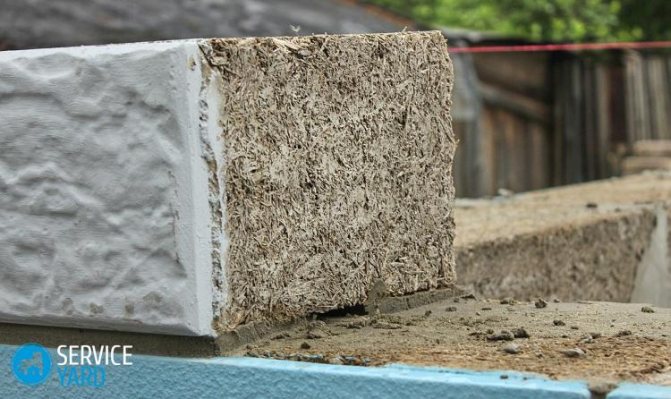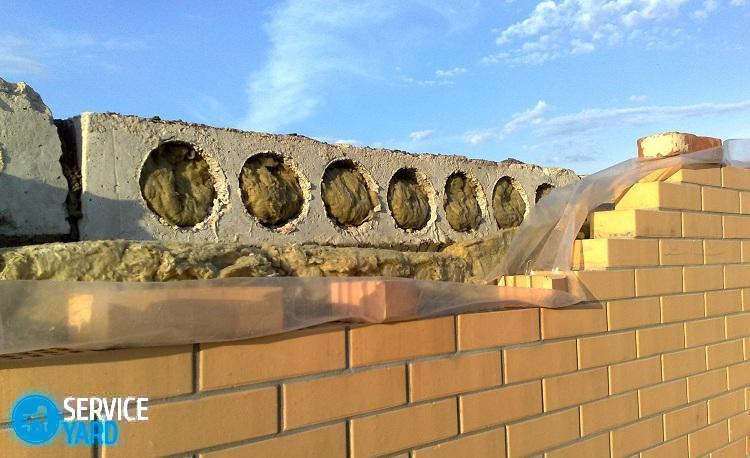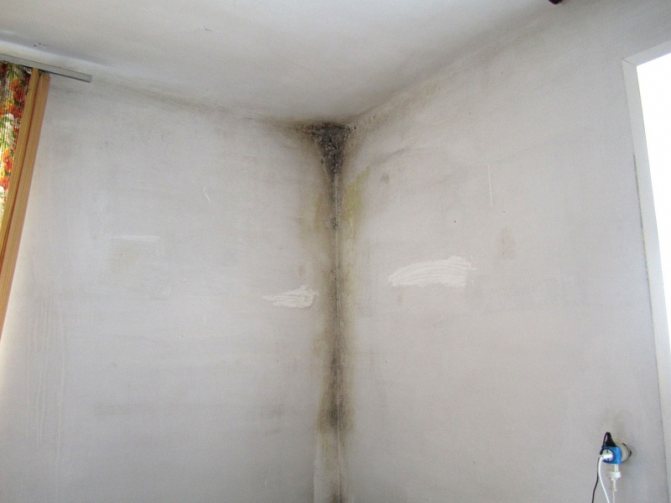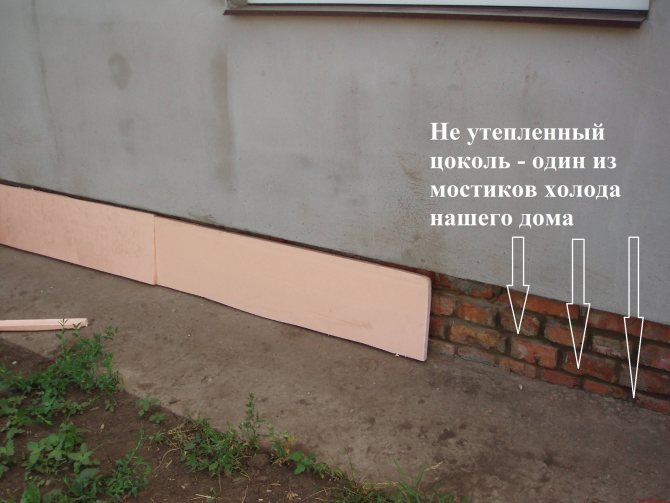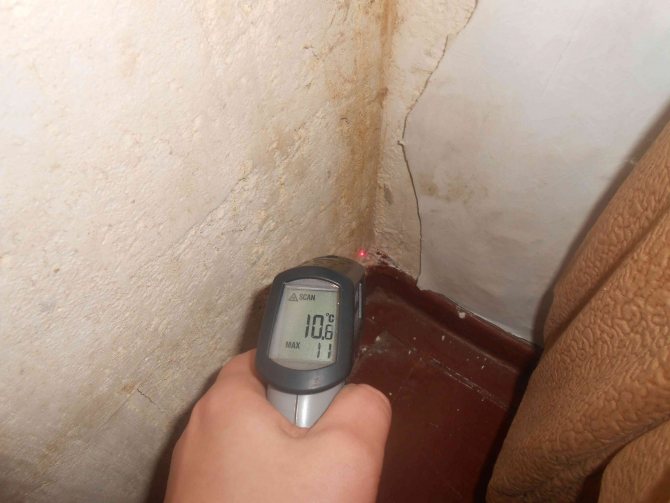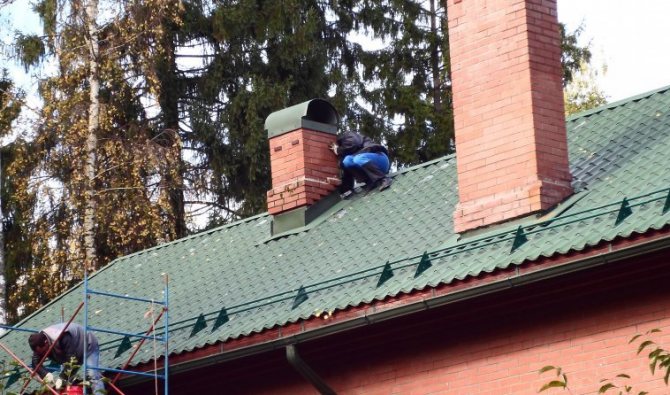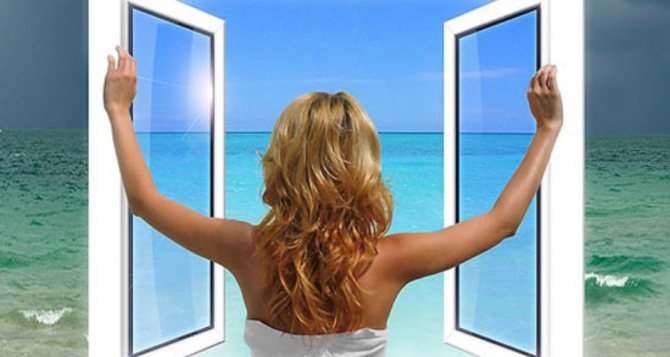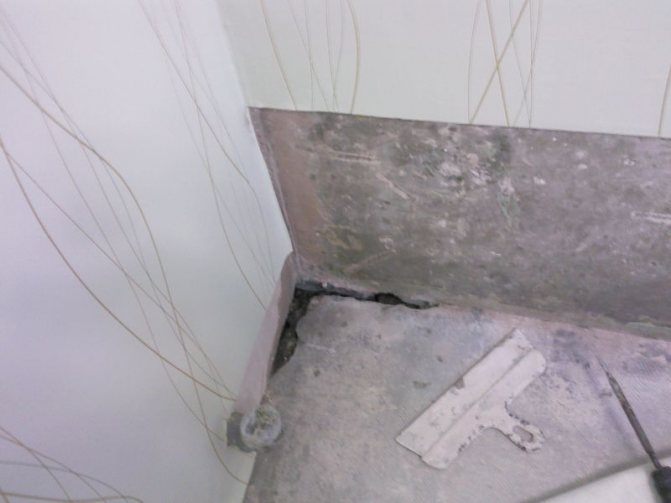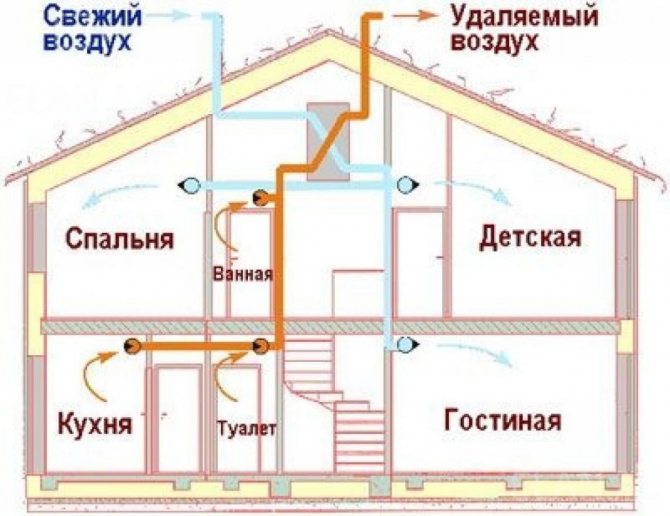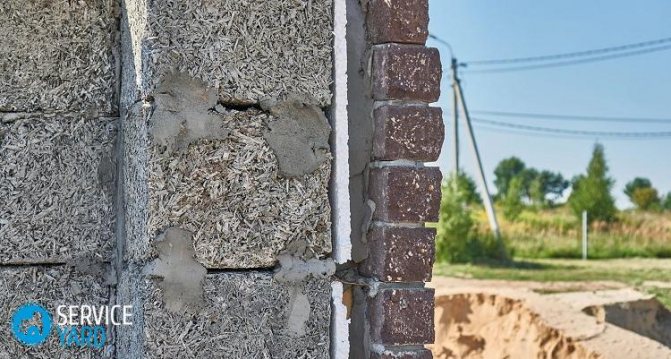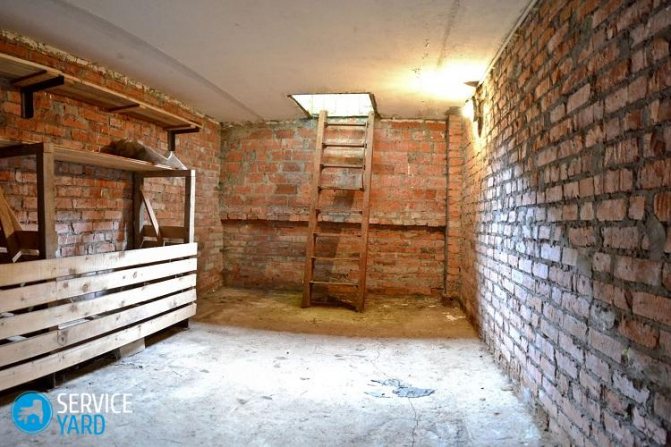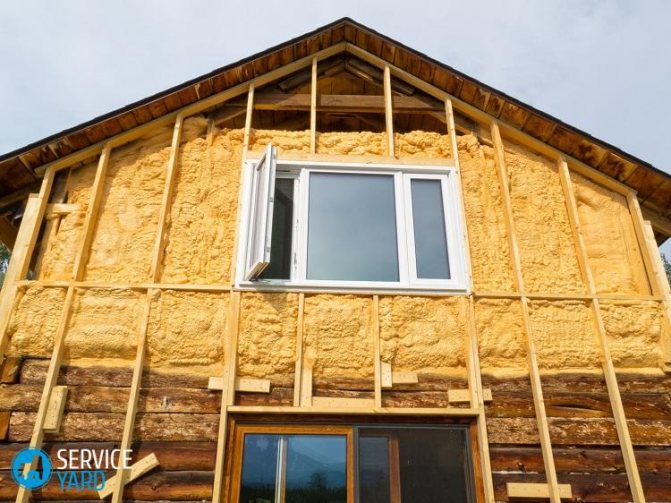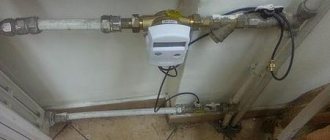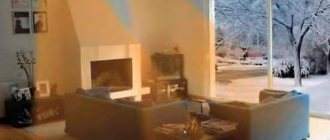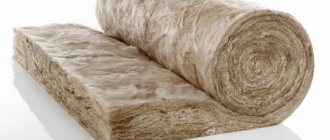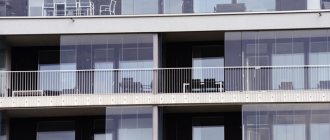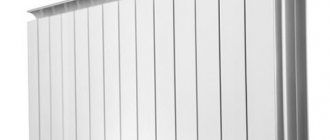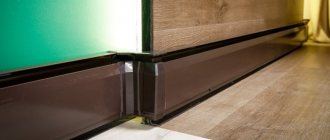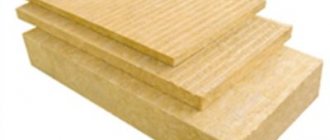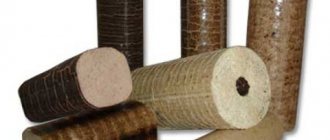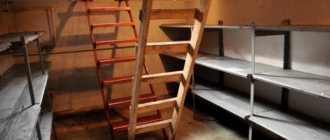The consequences when the wall of a brick house gets wet are fraught with the health of the person living in it and for the safety and longevity of the structure. Incorrect calculations before construction or errors in the construction of a structure create a dew point in the room, which provokes the appearance of moisture on the corners and walls of a brick dwelling. Because of this, mold and mildew appear. This situation can be corrected only with the correct thermal insulation and insulation of the corners.
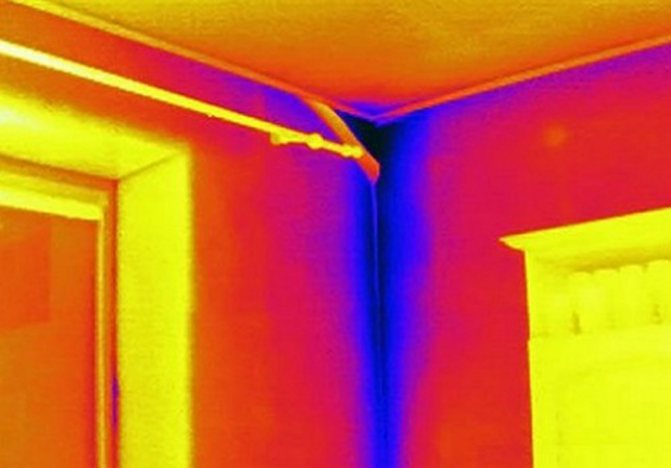
Reasons for freezing walls
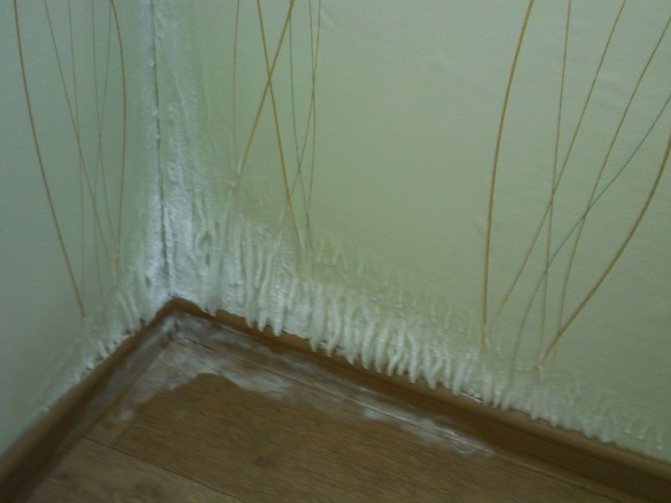

A cold bridge occurs when the walls are not properly arranged
Determining the cause of the freezing of walls is not such a simple matter. Walls can freeze through in any houses: brick and panel type, regardless of their location.
It is clear that the walls begin to freeze due to the appearance of the so-called cold bridge. The question under what conditions it can arise should be analyzed in more detail.
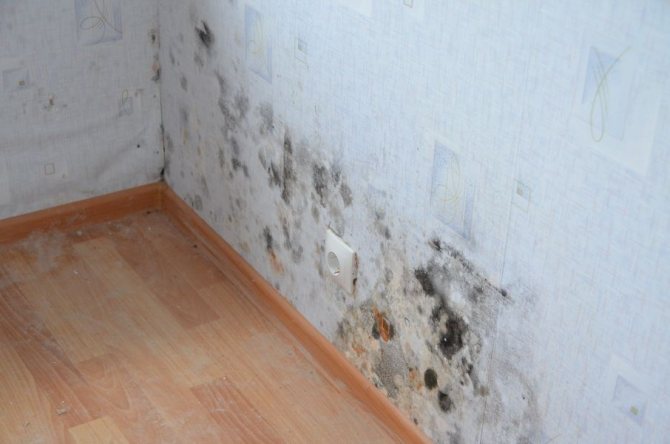

Often, freezing of walls goes hand in hand with dampness and the formation of fungus.
The main reasons for its appearance include:
- depressurization of interpanel seams;
- small wall thickness of a panel house (not suitable for climatic conditions);
- filling the walls with moisture both inside and outside (internal flooding with water from neighbors, rainwater ingress into the destroyed seam);
- the destruction of the building foundation leads to the divergence of the panels and cracking of the brick walls;
- a leaky joint between closely located houses (distance from 0.5 to 2 m).
All of these reasons can occur equally often. Each of them has distinctive characteristic manifestations.
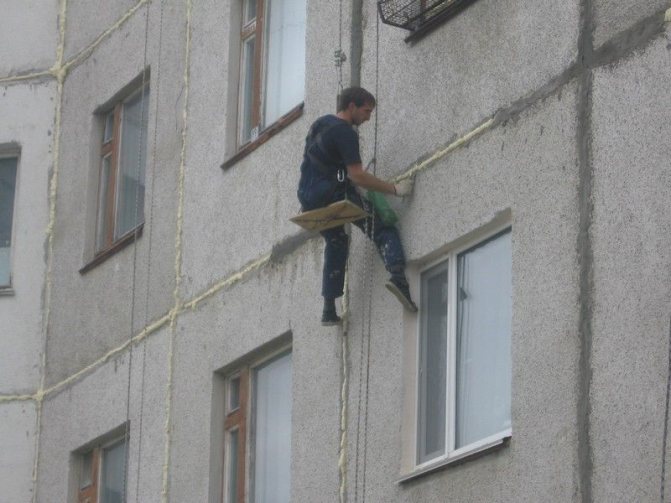

Violation of the integrity of the seams can cause the formation of a cold bridge
The cause of the outbreak and destruction of the seam between the panels can be:
- the use of an unsuitable material (mastic, sealant) for sealing joints (the location of the house and external environmental conditions play an important role);
- the work performed to insulate the seams was carried out by unskilled specialists, as a result of which voids remained in the sealed joint, where moisture enters, which changes its state with temperature changes and destroys the wall;
- the produced external wall insulation is not of high quality (if produced).
Cold bridges can appear not only in block buildings, the wall in a brick house also successfully freezes through, where there are no panels and seams between them. In this case, the reason is often an excessive amount of moisture in the apartment or a decrease in the temperature in the room.
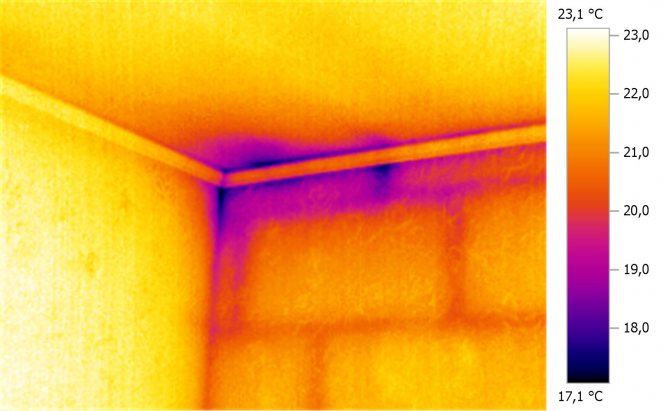

Cold corner
The temperature regime in a room or apartment may decrease for the following reasons:
- poor sealing of window openings (the production of the product or installation work was not carried out according to technology);
- not tightly and not hermetically installed entrance doors in the room;
- blows out of the ventilation system;
- airiness of the heating system;
- low temperature for heating the room.
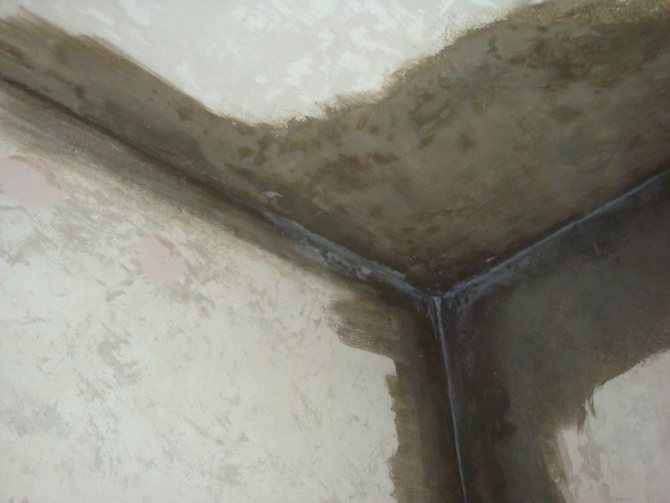

Moisture walls are also at risk of freezing in winter.
Many owners do not even know that they can make a freezing wall on their own, without knowing it.
Performing quite often wet cleaning of premises during the cold period, not correctly storing vegetables on the balcony and frequently watering a large number of indoor plants, each of us can harm ourselves by saturating the wall of the building with excessive moisture.
To prevent such processes from happening, it is necessary to often ventilate the room and prevent waterlogging in the rooms.
What to do
Before choosing a method for eliminating cracks, it is advisable to conduct a test to determine the state of the structure and find out whether this process continues or not.
To do this, take a paper tape, indicate the date of its installation, and then observe the process for several months. If the tapes remain intact, then the process has stopped.
If the tape breaks, the first step is to find out the reason in order to understand how to proceed.
In the case when the crack does not grow, it is sealed with a heat-insulating material, after which it is plastered. When the facade is tiled, one cannot do without partial re-laying of bricks.
After examining all the factors due to which the crack expands, the following way to solve the problem is chosen:
- metal conductors are used to fasten the masonry walls;
- partially rearrange the wall;
- lengthen the current wall or reinforce the internal ones, which will create additional strength and immobility of the building;
- carry out work to strengthen the foundation. The most difficult way, requiring the help of not only a specialist, but also special equipment.
Walls and corners in a brick house freeze through due to irregularities in the course of construction or incorrect design. It is best to resort to an external method to eliminate this disadvantage, but additional internal heat and waterproofing will be cheaper.
Eliminating the problem
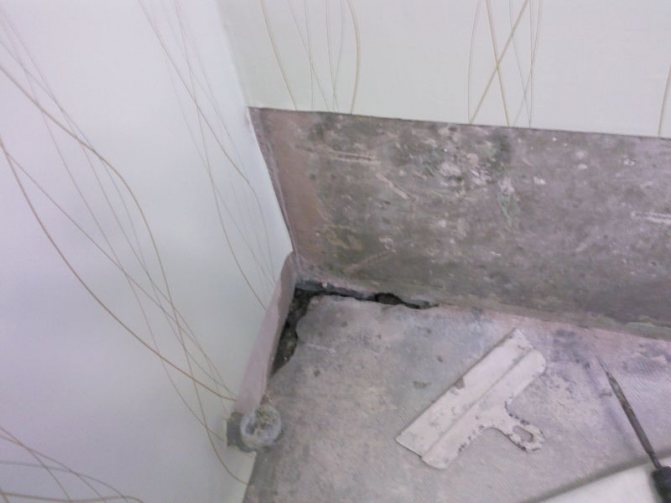

The problem of freezing is eliminated by organizing internal or external insulation
If you yourself have found freezing zones on the walls, you should immediately take appropriate measures to eliminate this problem.
Often there are situations when the tenants of an apartment building cannot get the heating power to be added from the heating network, and electricity tariffs are constantly growing, and there is no other way out but to insulate the room on their own.
Before proceeding with the insulation of an apartment, you need to decide which of the options for thermal insulation of the room you choose: internal or external insulation.
For the production of outdoor insulation, it is necessary to invite industrial climbers or use the services of an elbow tower.
Internal insulation of a room, wall or apartment as a whole can be done independently, but this will significantly reduce the volume of the room. So, which of the options for sealing and sealing the wall to choose, it is up to each owner individually.
Additional insulation
Most often, the outside of the house is insulated with foam.
As mentioned above, 2 types of thermal insulation can be used for a frozen wall: external and internal.
Despite the fact that skilled workers are involved to insulate the building from the outside, each owner should know how this process takes place.
When performing external work on the insulation of the facade, polystyrene is used as a heater, which is glued to the wall and fixed on the dowel in the form of a "fungus".
After that, the outer surface of the insulating material is reinforced with a plaster mesh (glued to the adhesive), on which a decorative coating is applied in the form of facade paint or decorative plaster.
You can see an illustrative example of external insulation layers in the diagram below.
To carry out internal work on wall insulation, an additional frame is created from an aluminum profile or wooden bars. The width of the frame depends on the thickness of the insulation used.
When creating additional thermal insulation for rooms inside, mineral stone wool is most often used, since it does not contain harmful impurities and has excellent thermal conductivity.
On top of the installed insulation mats, a layer of vapor barrier coating is attached to protect against moisture penetration. For more information on the physics of wall insulation, see this video:
It is recommended to use maximum density mineral wool for internal insulation of premises. Despite the fact that such a product will be quite expensive, you can resort to minor reductions in the room, while creating good thermal insulation and sound protection indicators.
Causes of dampness
Sources of dampness in the corners of rooms are obvious and hidden. Some are easy to find, while others will have to be searched. However, all the reasons why the corners in the house are constantly damp are divided into two subcategories - internal (poor ventilation, insufficient heating) and external (increased thermal conductivity of the wall, water penetration from the outside, etc.).
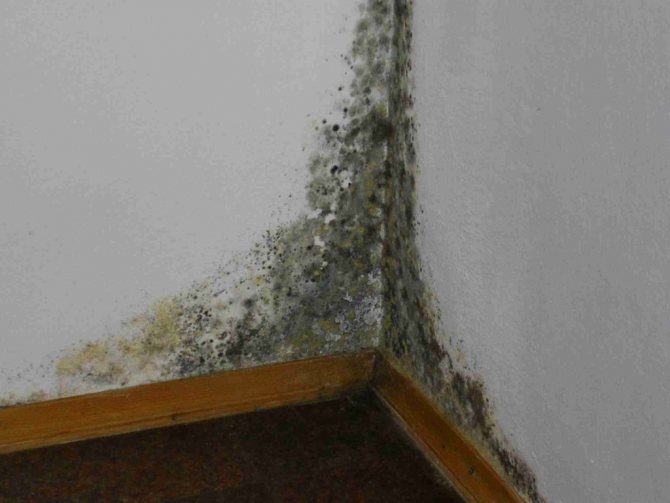

A damp and blackened corner
Often dampness appears in the corners of the room in such cases:
- there is a "leakage" of the wall (water can enter through cracks in the wall from the attic, drainpipes or eaves);
- the wall freezes (the corners "cry" from the fact that a "cold" bridge has formed due to the increased thermal conductivity of the walls);
- the heating capacity in the room is insufficient;
- there is no ventilation or it is ineffective;
- a fungus has formed on the walls;
- the foundation of the house is poorly waterproofed;
- there is a lot of washing and drying in the house;
- there are no hoods in the kitchen and bathroom;
- a void has formed in the seams not filled with mortar;
- the outer walls are too thin;
- voids have formed in the floor slabs;
- cooling occurs through metal beams or reinforced concrete structures;
- there is too much water and moisture in the basements;
- balcony slabs are poorly embedded in the wall;
- condensation appears on the ventilation pipes due to improper vapor barrier.
Freezing due to cracks, the reasons for their appearance
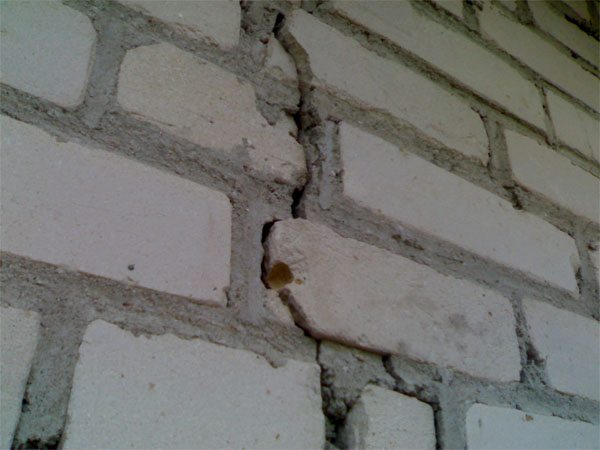

Photo of a crack in the wall.
The owners of brick houses may also face such a problem as the appearance of various cracks - vertical, horizontal, oblique, cobwebs, etc. All this is the result of mistakes and miscalculations of the construction itself.
Depending on how the wall of a brick house cracked and the type of cracks, the main front of measures is determined that should stop their further appearance.
The existing cracks must be processed, since without carrying out the appropriate work, the process of destruction of the house will, albeit at different rates, occur.
The reasons for the appearance of cracks can be the following:
- natural shrinkage at home, the process takes 1-2 years;
- high load on the floors, due, for example, to a heavy roof;
- deformation of load-bearing beams;
- deformation of the foundation for various reasons, one of them may be a high level of groundwater and their uneven freezing / thawing or insufficient depth of laying,
- as well as the influence of many other factors.
How to read cracks correctly
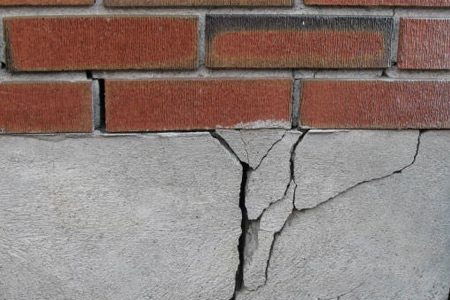

Photo of cracks in the plinth.
Most often, cracks are evidence of the so-called "house shrinkage". Given the total weight of a brick building, it is quite natural, but this is not always the reason. Violation of construction technology often more affects their appearance.
For example:
- The appearance of clear vertical cracks is evidence of problems with the foundation:
- insufficient depth for this structure;
- the adverse effect of heaving or moving soils on it.
- Oblique cracks appear as a result of several reasons:
- subsidence of soils, due to their heterogeneity;
- houses directed in a certain direction indicate a possible, albeit outwardly not yet noticeable, subsidence of a particular corner of the house;
- multidirectional evidence, as a rule, of a plurality of ground subsidence sites.
- Horizontally oriented cracks appear, most often, due to a violation of the brickwork technology and especially due to the quality of the banding of the rows. Their main manifestations:
- bending of window, door, beam floors;
- the critical moment is the extrusion of some of the floors, but in this case the insufficient strength of the floor itself is to blame.
- Horizontal arcuate cracks result from:
- large weight of floors;
- inappropriate to such ceilings of the wall and (or) foundation.
- Vertical cracks can appear in the masonry itself, as a rule, at the junctions of two buildings. Their reason is the absence of an expansion joint. Their device in such cases is necessary in order to avoid the consequences of the different shrinkage rates of the two combined buildings.
- Cracks can also appear from some other reasons not related to the construction process, for example, the lack of an ebb for rain or other ingress of water on the wall, into the micropores of the brickwork. This is especially dangerous in winter or during thaws, since at subzero temperatures, frozen water works like a wedge, destroying masonry. This type of cracks is quite well recognized by the characteristic "path".
Also, the reason for the cracks can be judged by their appearance:
- expansion from below - the overlap exerts increased pressure on the wall;
- expansion at the top of the crack - the foundation of the house settles from the corresponding side.
Possible ways to eliminate cracks
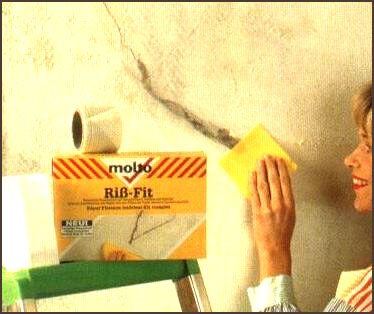

Photo - crack elimination.
Before choosing a method of how to eliminate and repair cracks, it is necessary to conduct a test aimed at determining the present state of the structure, for the presence of an ongoing or already stopped process.
For this, special control marks are used: the date of their installation is recorded on a paper tape and monitoring is carried out for several months. If the tapes do not break, then the process of shrinkage or other processes has stopped, and most likely new cracks will not appear.
And if on the contrary, you will have to find the reason for their appearance in order to develop an appropriate work plan.
If the crack no longer has a tendency to expand or enlarge, it is sealed with heat-insulating material and plastered. A tiled façade may require partial re-bricking to restore the aesthetic appearance of the home.
And if the tape broke, then by the time during which it happened, as well as by the type and direction of the break, a preliminary cause is determined, followed by a more thorough study of all factors.
The way to solve the problem will most likely be one of the following:
- the use of metal conductors to fasten the masonry of the wall;
- re-laying part of the wall, if technically possible;
- you can apply the method of lengthening the load-bearing wall or strengthen the internal ones, which will give additional strength and immobility to the structure;
- partial alteration with the implementation of measures to strengthen the foundation is the most difficult and costly way, do everything with your own hands, it will not work here, you will need advice and help from specialists. In addition, you may need to use special equipment.
Eliminate dampness in corners
Attentive owners will always notice damp corners in time and establish the cause of sputum.
After finding the culprit of the problem, you can start fixing it:
- If the wall freezes, you need to take measures to insulate it. The most effective is the insulation of the walls from the outside. It will not only reduce dampness, but also reduce heat loss. This is done either with mineral wool or foam. However, for apartment owners in high-rise buildings, such insulation is a rather troublesome business. In case of problems with external insulation, you can insulate the wall inside the room.
When applying insulation from the inside, thermal calculations should be made in order to avoid the appearance of condensation and moistening of the insulation material, as a result of which its insulation properties are lost.
- To make correct calculations, the humidity in the room, the climate, the degree of thermal conductivity of the wall, etc., are taken, therefore, in such cases, expert advice is simply necessary.
- If the heating system is ineffective, additional sources of thermal energy should be used. This can be an electric fireplace, a stationary battery, a radiator or other alternative heaters, which are recommended to be installed in places where the most dampness is.
- If condensation appears due to excessive tightness of the room after installing plastic windows, the room should be ventilated more often.
- If the thickness of the walls is insufficient, it is recommended, if possible, to veneer the building from the outside with an additional ball of brick or apply insulation under the plaster. From the inside, the walls can be insulated with a slab insulation (polystyrene, mineral wool), placed on the frame with 5 cm walls to fill it with expanded clay. This building material will absorb moisture from a damp wall and prevent mold from spreading.
- You can improve ventilation by installing an additional hood, and even at the bottom of the door when entering a separate room, you can make a slot for air regulation. Ventilation should also be improved in the bathroom and kitchen, which are most often sources of dampness.
- In the presence of a basement under the dwelling, moisture can penetrate through microcracks in the floor, as a result of which the walls become damp. To eliminate such a problem, the floor is treated with an anti-fungal agent, a moisture-resistant base is laid on it, and all the cracks are sealed with a sealant.
- If the cause of the damp corners is the fungus and mold on the plaster that has appeared in the wall, then all the affected areas are treated with antifungal solutions, plaster, if necessary, with a high-quality mixture, and only after that new wallpaper is glued.
- In case of poor-quality installation of balcony slabs, moisture penetrates into the seams, therefore, the joints between the slab and the wall should be sealed so that there are no leaks that lead to damp spots.
- When capping seams in external walls, care should be taken to ensure that closed and open joints provide air protection, and the latter, moreover, are well protected from moisture.
How to prevent freezing of corners in the house?
What can be done to prevent freezing of the corners of the house? Practice shows that some architectural changes, for example, rounded or beveled corners in a house, can prevent the problem of freezing. Also, to protect against freezing, pilasters can be made at the outer corners of the building.
And what can be done in log houses? During the construction process, it is necessary to fasten the crown-logs at the corners with a special cut-down lock with an embedded natural heat-insulating material. This procedure will reliably protect wooden houses from freezing of the corners.
And in conclusion, one important piece of advice to everyone who plans to purchase a suburban home. Currently, there are companies that are engaged in thermal imaging of buildings. With its help, you can find places of heat leakage in order to decide before buying whether it is possible to eliminate the mistakes of builders. This procedure is able to save the future owner of the house from the problem of freezing the corners in it.
Freezing the corners of the house
- a nuisance that residents of both a panel Khrushchev or a new brick building, and a country house, whether it be wooden or stone, may face. Fortunately, you can solve this serious problem on your own. Let's talk about how to properly get rid of
freezing the corners of the house
.
WHY CORNERS FREEZE
Cold bridges make corners the most vulnerable part of almost any home. These sections of the building structure have increased thermal conductivity. Any vertical or horizontal angle is a geometric cold bridge.If a building defect is allowed - poorly sealed seams, through voids in concrete, an insufficient layer of mortar between the bricks, the lack of the necessary insulation - problems cannot be avoided. Where there are cold bridges, the surface temperature of the wall in winter can drop below the dew point (up to about 9 ° C and 50% humidity) while maintaining the room temperature indoors. It is in such places that condensation forms due to the temperature difference, which leads to the formation of mold, and when it freezes, it turns into ice crystals.
The most logical solution in this case seems to be the laying of insulation from the inside along the walls. But any such material is essentially a heat insulator that equally insulates the wall from heat and cold. The use of insulation can even worsen the situation, since it will shift the dew point (the place where cold and warm air comes into contact) to the inner surface of the wall. As a result, the cold air from the street will freeze the wall through and through, since the heat from the apartment will not be able to penetrate the heat insulator layer. Wetting and freezing will continue, the insulation will become unusable and will cease to perform its functions. In addition, ice crystals will continue to erode the wall material, further increasing the cold bridges.
When buying a country house or an expensive apartment, you can use the services of companies offering thermal imaging. Experts will help detect all heat leaks and conclude whether it is possible to correct builders' mistakes. This can save the owners from many troubles associated with the operation of the house, and will save significant money.
GETTING RID OF FREEZING CORNERS
The ideal way to solve the problem is to insulate the entire facade from the outside and reliably seal the seams. It is quite possible to repair your own country house, but in an apartment building you will have to turn to the management company for help. But don't despair. And in a single apartment, you can get a good result.
First of all, you need to remove the wallpaper. If there are no visible cracks, then the walls are tapped with a hammer - where there are voids, the sound will be dull. Next, remove the plaster over the detected cavities and thoroughly dry the corner. If there is mold, be sure to treat it with special antifungal agents. Sometimes mold damage is so extensive that acid, blowtorch fire, or surface milling is necessary. All cracks and voids are filled with polyurethane foam or liquid foam. This will prevent moisture from entering the room, even if there are cracks in the outer wall. Finally, scrape off the remaining foam and plaster the corner. It is best to carry out work in the warm season in order to completely get rid of dampness and mold indoors.
In the event that very large voids are found, do not fill them with mineral wool or tow, as these materials contribute to the accumulation of moisture. It is better to use the same polyurethane foam. It is resistant to moisture, does not rot and mold, has high adhesive properties, does not lose its qualities when frozen.
Insulation of the entire facade from the outside
Today, manufacturers offer a variety of materials that greatly facilitate the repair process and take it to a qualitatively new level. For example, special heat-insulating ("warm") plasters are light mixtures in which microscopic expanded polystyrene granules or light natural aggregates are used instead of sand. Such plaster is several times lighter than usual, it is well applied and adheres. Due to the presence of air pores, warm mixtures have a high vapor permeability, regulate condensation and provide a healthy indoor climate.A layer of warm plaster of 50 mm in terms of the insulating effect is equivalent to a masonry of one and a half to two bricks or a two-centimeter layer of expanded polystyrene.
Not so long ago, new materials appeared on the market, produced by different manufacturers under different
If a wall in a brick house freezes, what to do in this case? The question interests all the owners. Failure to comply with building codes is the most common cause of a building's thermal insulation failure. In turn, such problems not only lead to a decrease in the temperature inside the building, but also contribute to the development of mold, which occurs in those places where the insulation is weakest. Similar manifestations can do a lot of harm and affect the health of people living inside the building.
Freezing of a wall in a brick house most often occurs due to non-compliance with building codes.
Preventing dampness
Keeping dampness to a minimum and preventing its occurrence in the future will allow compliance with some rules.
- The laundry must be dried outside living rooms or with the hood turned on for air extraction.
- When cooking, pots and pans should be covered with lids to prevent steam from escaping.
- In the bathroom, where the concentration of humidity is highest, as well as in the kitchen, hoods and ventilation openings should be regularly cleaned from excessive debris, and these rooms should also be ventilated daily.
- In a private house, you can insulate the attic, as well as cover the walls with waterproofing material, preferably with pores.
- All flammable substances that form a lot of moisture, in particular, paraffin, are rarely used indoors.
- Ventilate all rooms in the house daily.
- Eliminate errors in the heating system in time.
- Use a dehumidifier to reduce humidity. This household appliance can easily cope with the problem of dampness, and its compactness will allow you to transfer the dehumidifier from room to room.
Why does the floor and wall in the house get damp?
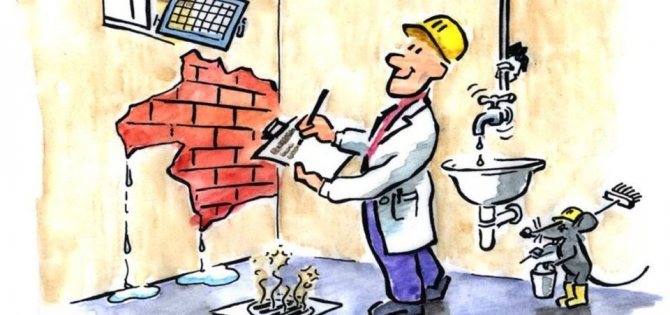

The wall in the house is damp
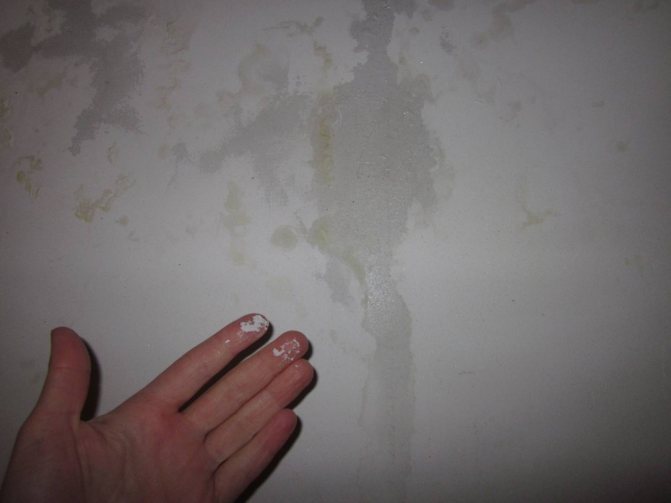

Dampness on the walls is a frequent occurrence; a part of the wall, a whole wall, or just the corner of a room can get damp.
Consequences of high moisture levels:
- Wallpaper peels off;
- The walls are darkening;
- A fungus appears;
- Heavy indoor air;
- The temperature drops.
Of course, first you need to find out why the dampness appeared, sometimes the reasons are immediately obvious and visible immediately, sometimes you need to carry out prevention and look at the result.
Reducing humidity
If the walls often get wet in interior rooms with high moisture (bath, bathroom), then the matter is most likely in the ventilation system. Therefore, first of all, you should check the ventilation holes for unnecessary objects that may interfere with air circulation.
It is easy to check how clogged the ventilation channels are: we bring the burning candle to the air vent and see how the flame reacts: if it reaches for the grate, then the channels are not clogged and there is a draft. When there is no reaction of the flame to ventilation, additional devices need to be installed in order to establish air circulation.
When the holes are not clogged, and the draft is still weak, then at the bottom of the door you can make additional slots for air intake. If this does not help, a forced exhaust is mounted in the ventilation duct. Such fans are turned on only when there are no people in the room, as they can greatly harm health.
Experts advise installing fans with a built-in humidity controller in the bathroom. When the moisture rises, the fan works automatically, eliminating the air saturated with dampness.
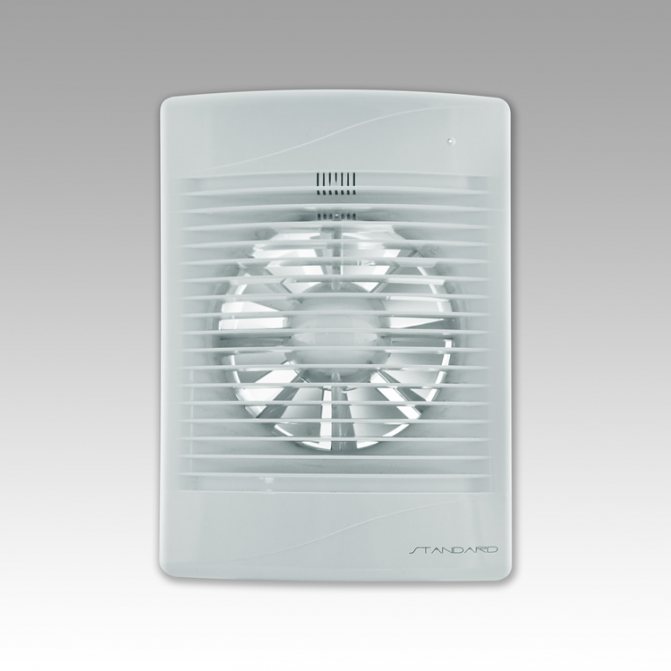

Why is it wrong to regulate the thermal conductivity of walls by their thickness?
Low thermal conductivity of solid bricks
The thermal conductivity of the currently produced solid brick is quite high, and the walls a meter thick will still not be as warm as in the noble and merchant buildings of the 18th century.It is known that high-rise buildings with 80 cm thick "Soviet" walls require additional heating in severe frosts. And even during the reconstruction of old wooden-brick buildings, they often simply immerse the lower brick floor into the ground, turning it into a kind of foundation, hoping that the additional costs for completion will be much less than the amounts that may be required for heating the lower brick floor.
Thermal conductivity coefficients of bricks:
"Super efficient" hollow brick: 0.25 - 0.26 W / m ° C
Hollow red brick: 0.3 - 0.5 W / m ° С
Solid red brick: from 0.6 to 0.7 W / m ° С
Sensitivity to sudden changes in temperature
A house with thick, non-insulated stone walls is extremely sensitive to sudden changes in temperature. It is enough to leave it for two or three days without heating, and moisture begins to condense inside the brickwork. This process rapidly captures more and more new layers up to the appearance of drops and ice crystals inside the room. The wall freezes, becomes loose, its thermal conductivity drops sharply to a catastrophic level, there is a danger of mold and mildew development. A damp multi-ton massif is very difficult to dry afterwards.
When is a thick wall good?
Thick stone walls are good for Mediterranean and tropical climates: there is no danger of freezing, seasonal and daily temperature fluctuations are smoothed out, in the heat you can do without an air conditioner.
Thick walls are risky and expensive. But well-insulated thin masonry in half or a quarter of a brick is another, completely unjustified extreme. The fact is that a moderately massive stone wall protected from heat loss is able to accumulate thermal energy and gradually release it into the space of the room. Warm, dry, brick walls are a great source of soft home warmth. They, like a sponge, absorb the energy of water heating systems or infrared emitters, and themselves become secondary sources of infrared energy. Comfortable conditions in such a room are quickly restored even after intense end-to-end ventilation; next to thick, well-insulated walls, you can put both a bed and a work table - their surface will not "cool".
Calculating the thickness of a brick wall
In calculations of this type, these parameters are used:
- dimensions of a standard brick: 250 * 120 * 65 mm;
- weight of one brick: 3.2 kg;
- the weight of one m3 of brick is 1600 kg.
At the minimum winter temperature, the wall thickness should be 51-64 cm, when using insulation from the street side, the thickness is reduced to 25 cm.
Based on the above, we will calculate the number of bricks for our house.
Let's take into account the fact that we live in an area with winter temperatures down to -25C °.
Wall dimensions:
- Height - 3 meters.
- Length: 2 walls 6 m each, 2 walls 4 m each.
Total wall area: 6 * 3 + 6 * 3 + 4 * 3 + 4 * 3 = 50 m2
The area of one brick: 0.012 * 0.065 = 0.0078 m2
Total number of bricks: wall area / area of one brick = (50 / 0.0078) * 2 = 12820 pieces. The multiplication by two happened because the wall will be built "in two bricks."
Total wall weight: weight of one brick * total number of bricks = 3.2 * 12820 = 41024 kg
Required volume of bricks: total weight of walls / weight of one m3 of brick = 41024/1600 = 25.64 m3.
To determine the cost of a brick, you only need to know the cost of one cubic meter. Further, this figure is multiplied by the required volume of bricks and the amount of one of your basic construction costs becomes clear.
Reasons for freezing walls and corners
Frost on the walls of rooms, as a rule, forms in apartments that are located in the corner of the house or are directed towards the wind.In addition, this is often a problem in cases where the outer wall is adjacent to buildings or an elevator shaft, rooms that are provided with sufficient temperatures for heating.
Important! Regardless of the location of your home, the main reason is insufficient sealing of the joints between the walls, so icing is usually observed in the corners of rooms. If the amount of waterproofing material is insufficient, over time you will become familiar with the problem of high humidity inside the walls, as a result of which - with freezing.
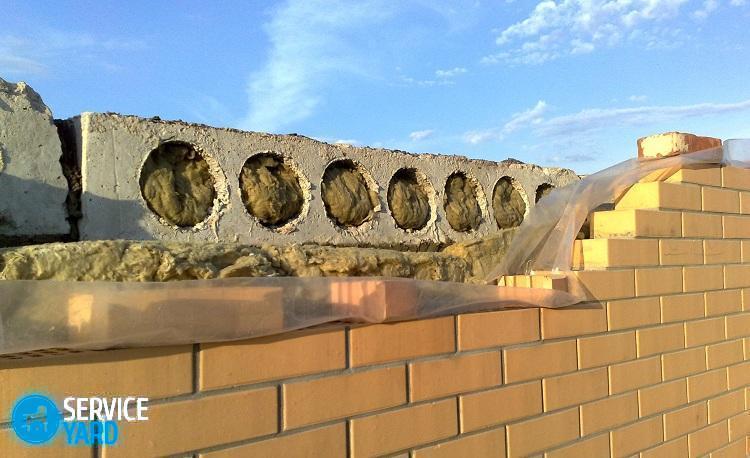

What are the reasons for the deterioration of waterproofing at home?
As a rule, freezing of walls is associated with a violation of the very structure of the house:
- In panel houses, such a problem can be insufficient thickness of partitions and ceilings, subsidence of the building, as a result of which the walls acquire cracks.
- If in the apartment, as well as on the street, you simultaneously observe high humidity and low temperature, then the wall of such a room will rapidly absorb water, which in the future will transform into frost.
- Another common prerequisite for freezing is incorrect wall insulation inside the room. If the thickness of the insulating material is insufficient, and the work was carried out without strict adherence to technical rules, then soon you will encounter increased wall moisture, the formation of mold and mildew.
Important! Such defects are fraught with damage to cosmetic repairs and compromised health of homeowners, so these problems require immediate elimination.
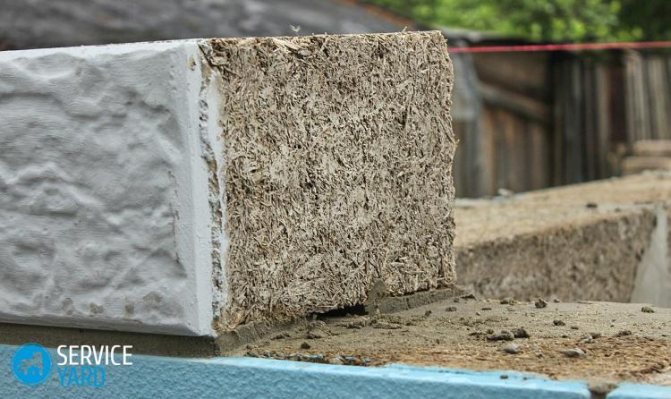

Among the other reasons why the wall freezes, they determine:
- depressurization of interpanel seams;
- in winter, insufficient heating of the house;
- violation of the sealing of windows, balconies and loggias, doorways;
- constant drafts;
- frequent increase in humidity by the apartment owners themselves;
- terrible exhaust system as well as ventilation.
No additional insulation
If you live in a region with a minimum of warm days per year and very cold winters, condensation will certainly form on the thin walls and joints. This is explained by the fact that it is warm in the apartment of a panel house, but not outside. Due to such a temperature difference, condensation forms at the most vulnerable points of the wall - the corners. Reacting with subzero temperatures outside, moisture freezes and freezes on the walls.
How to eliminate the inconvenience?
Before proceeding with a comprehensive prevention of the consequences, find the place of freezing and determine the cause. To do this, examine the wall very carefully and try to find out what caused the frost to appear.
If you have already found the cause, you should proceed to eliminate the resulting defects. For this procedure you will need:
- composition for leveling walls;
- brush, spatula;
- coarse sandpaper;
- acrylic primer.
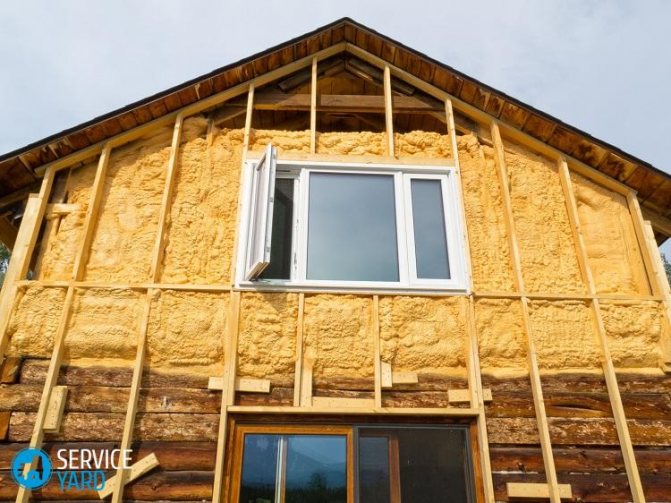

To grout the cracks, proceed as follows:
- Remove tiles, wallpaper, or paint from the wall.
- Treat all existing cracks and cracks with a putty or other mixture that is designed to level the walls.
- After drying, level the wall with sandpaper.
- Apply a primer.
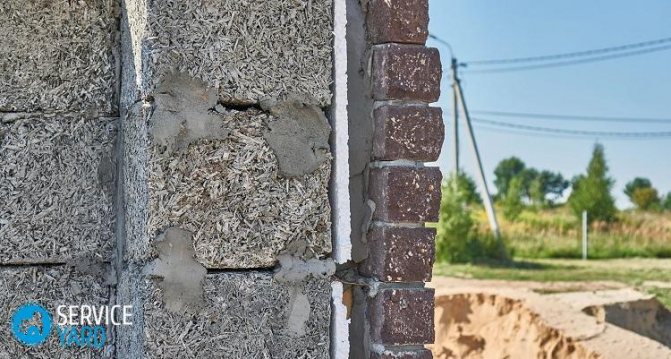

We recommend doing the entire procedure several times, gradually increasing the grout layer.
Important! You should not use mounting foam to fill cracks, since it perfectly absorbs moisture, letting in all the excess water inside the room.
However, the above method is just the elimination of the consequences, but not the reasons for the freezing of the walls. In order to get rid of the main problem forever, you will need high-quality and effective external wall insulation.
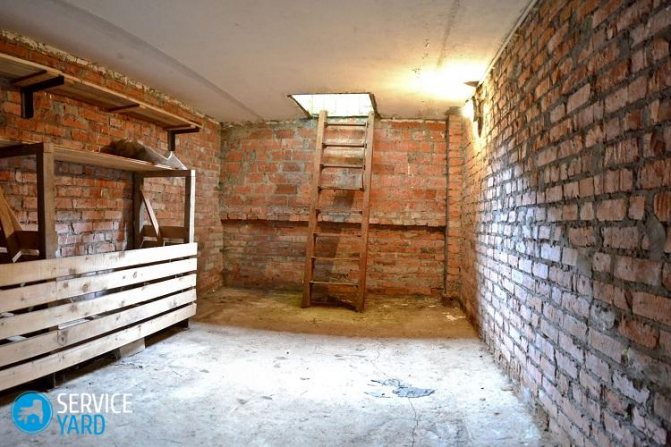

Warming problem areas
Wall insulation is most preferable to do outside, because internal insulation has a number of disadvantages:
- Internal thermal insulation, due to the thickness of the materials used, can significantly reduce the size of the usable area, which is quite important for the inhabitants of panel houses.
- Failure to comply with the correct insulation technology is fraught with an even worse condition of living conditions and increased humidity in the apartment.
- With the help of internal thermal insulation, you will not avoid the need to change heating and ventilation systems.
Important! Internal insulation also has a number of advantages. You will not need to obtain permission to convert the facade from the management company. In addition, you can insulate the apartment from the inside on your own.
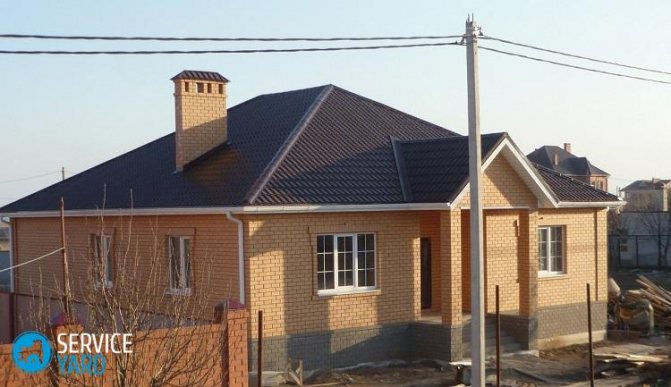

Panel houses can be insulated with warm plaster or liquid materials. However, all these modern materials are still insufficiently studied. Moreover, such means do not solve the problem of dispersed interpanel seams, as well as cracks. It is recommended to insulate the house from the front side. If you live above the first floor, you will have to seek help from a construction company, which will take over the entire process.
With the help of insulation, the thickness of the walls will increase quite strongly, which will increase the average temperature in the living room. In addition, by capturing approximately 30–40 cm of the neighboring wall, you can completely solve the problem of blown interpanel joints.
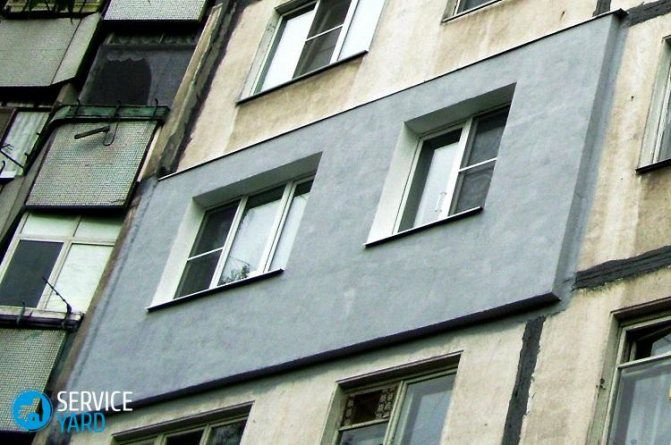

A corner in the house is freezing. What to do Solutions.
Siding is a new trend in modern construction. With the help of siling, you can not only insulate, but also decorate your home. In this article, we take a closer look at the siding installation process.
If none of the organizations to which the appeal was made does not take any action, it is necessary to address a complaint to such state bodies as:
- the prosecutor's office;
- city or district administration;
- TO housing inspection;
- court.
When this cold bridge comes into contact with the warm air of the room, the following physical phenomenon occurs on its surface - a "dew point" is formed, i.e. water vapor in the air begins to condense and turn into droplets. The wall begins to get wet in this place, and in winter, when the temperature drops, it naturally freezes.
When returning home, each person expects a cozy atmosphere, but the feeling of warmth is difficult to maintain in a room with frozen walls. This problem is especially common in old panel houses.
Why does the wall freeze in an apartment of a panel house?
The presence of a large amount of moisture in the wall of the house leads to its freezing. Through a damp wall, frost will get to your apartment much faster.
Among the many reasons that lead to such a situation, we highlight the main ones:
- Poor or damaged waterproofing can be the cause. This problem is most urgent for residents of high-rise buildings on the last floors;
- Poor ventilation in the room can also lead to the accumulation of moisture in the wall, since the walls do not have time to dry out;
- Poor quality work of builders during the construction of a house, poor processing of cracks, unscrupulous sealing of windows and other openings;
- Weak heating during the cold season. Here, the reason is that the walls do not warm up well, therefore, they do not dry out, and moisture begins to accumulate in the panels of the house.
- A house that requires major repairs. This is the most difficult situation in terms of correction. The numerous cracks that appear in the panels of the house and grow larger every year also collect moisture in the wall.
Find out how to solve exactly your problem. Write your question through the form (below), and our lawyer will call you back within 5 minutes, advise free of charge.
Some ways to eliminate manifestations of freezing
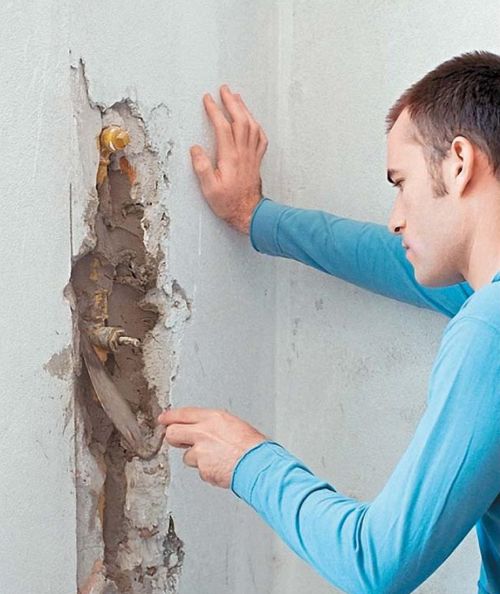

In the photo - the search for the cause of freezing.
You should not immediately take measures to insulate the room - simple insulation, especially from the inside, will not give practically any effect, but will only shift the dew point, and moisture will condense in another place.
For example, cold air will come into contact with warm air indoors. And this will significantly worsen the situation.
Advice. The problem is revealed, as a rule, in the cold season, but it must be solved in the warm season, when there is an opportunity to dry the house in general and problem areas in particular.
The most optimal option:
- sealing seams;
- facade insulation;
- thermal insulation of the foundation.
Although the thermal insulation of the facade is unlikely to be possible if the facade is faced with decorative or facing bricks. In this case, the only way out is to carry out internal insulation work.
Although the effect of them is much lower, but if performed correctly, this will solve the problem associated with freezing of corners and walls.
Insulation and insulation of problem walls and corners inside the house
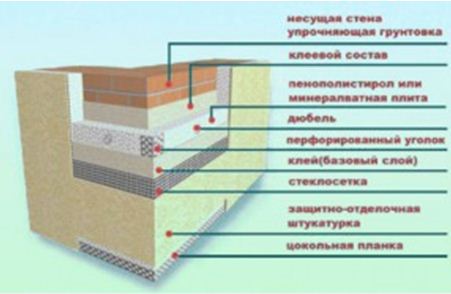

The photo shows complete protection of the wall from cold and dampness.
If the problem appeared in the house after the completion of all finishing work, most likely it will be necessary to do the repairs again, since cosmetic measures will not give a result.
It is necessary to carry out the following work:
- remove wallpaper, plaster;
- embroider the seams;
- treat seams and walls with antifungal compounds;
- the next serious operation is how to dry a brick house, that is, dry the walls and the room itself... For this, it is best to use heat guns, but household heating devices can also come in handy;
- re-fill the seams, voids or cracks that appear with polyurethane foam, liquid foam formulations, you can use the so-called "warm" types of plasters, which contain particles of expanded polystyrene, which has high heat-insulating properties;
- cleaning the treated seams and surfaces and preparing them for plastering work;
- execution of plaster, most often several layers are required, for the first, again, you can use the same "warm" plasters, but you can use the usual one, but with the addition of hydrophobic additives, the instructions detail how to use them;
- in addition, you can apply a layer of liquid insulation with excellent adhesion characteristics... Outwardly, it resembles paint, applied with a roller or brush. In addition to the main function, it has both antifungal and anti-corrosion characteristics, which allows processing with this material, for example, anchors for fastening ventilated facades, significantly leveling the effect of "cold bridges".
Application of non-standard architectural and design techniques
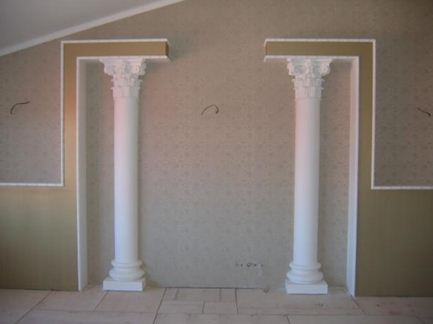

In the photo - pilasters.
There is an architectural way to avoid the formation of the so-called geometric "cold bridges" - the device of beveled or rounded corners of the building. But not everywhere, for obvious reasons, this method can be applied. However, it is quite possible to arrange pilasters or other decorative elements on the front part.
If a corner in a brick house gets wet, for the same purpose, when installing a multi-level ceiling, you can make a special box or niche into which you can mount the backlight.
In operating mode, it is an excellent heating device in order to warm up the air, and thereby move the dew point from the room deep into the wall or even closer to its front part. Similarly, you can arrange a vertical version of such a design.

